In this blog, A. G. Adeeth Cariappa discusses how carbon credits can be used to incentivize farmers to adopt measures that can support climate change mitigation and how agricultural extension can spread the word.
“The era of global warming has ended; the era of global boiling has arrived. The air is unbreathable. The heat is unbearable… It is still possible to limit global temperature rise to 1.5 degrees Celsius and avoid the very worst of climate change. But only with dramatic, immediate climate action.”
– António Guterres, U. N. Secretary General
CONTEXT
Global warming is a result of the greenhouse gas (GHG) effect caused by emissions of GHGs such as carbon dioxide (CO2), methane (CH4), and nitrous oxide (N2O). These gases trap sun rays in the atmosphere, leading to excessive heat. The higher the concentration of GHGs in the atmosphere, the higher is the heat. Human activities, including electricity and heat production, transportation, agriculture, and land use changes, among others are the primary sources of GHG emissions. Agri-food systems contribute around 1/3rd of global GHG emissions (Crippa et al., 2021).
Climate change mitigation is particularly important for lower-middle and low-income countries, where agriculture’s share in total GHG emissions is higher compared to high-income countries. Agriculture accounts for 48% of total emissions in low-income countries and 7% in high-income countries (Ritchie et al., 2020). Moreover, measures to reduce GHG emissions can be cost-effective in middle- and low-income countries (Glennerster & Jayachandran, 2023). Though agriculture is one of the major contributors to GHG emissions, it can also play a crucial role in climate change mitigation. Carbon credits (Box 1) can help mitigate climate change while benefiting farmers.
|
Box 1: Understanding carbon credits Carbon credits form the foundation of these carbon markets. Entities such as individuals, companies, or governments can receive financial incentives for reducing their emissions below a certain baseline. The emission reduction is quantified in the form of carbon credits, which can be traded in carbon markets. One carbon credit is equivalent to one metric ton of carbon dioxide equivalent (CO2e), a unit that combines the warming potential of CO2, CH4, and N2O. |
THE ROLE OF CARBON CREDITS IN AGRICULTURE
Carbon credits are seen as a solution to mitigate climate change by rewarding GHG emissions reduction or carbon removal from the atmosphere. In the context of agriculture, carbon credits can be generated by implementing sustainable practices that reduce emissions or sequester carbon. How does this process work and how can it impact agriculture and farmers? We now know that GHG emissions from agricultural residue burning in India has increased by 75 % since 2011 (Deshpande et al., 2023). Consider a paddy farmer who traditionally burns residues after the Kharif season’s harvest. Assuming a carbon company or an NGO approaches farmers and convinces them not to burn residue, and they propose a plan of action: after verifying that the farmers have not burnt crop residue in the next season, they will provide a specified amount of money. The farmer agrees to this arrangement and does not burn crop residue in the next season.
Let’s say that by not burning residues, the farmer achieves a reduction of 1.5 tonnes of CO2e per hectare compared to the previous season’s baseline. This reduction translates to the generation of 1.5 carbon credits per hectare, with the understanding that 1 tonne of CO2e is equivalent to 1 carbon credit. Assuming a market value of US$ 10 per carbon credit, and with the agreement specifying that 60% of the revenue reaches the farmers, the farmer who avoided burning rice residues would receive an estimated amount of approximately INR 750 per hectare[1]. It’s important to note that the disbursal of funds to the farmer is contingent upon a third-party verifier confirming that the farmer has indeed not burnt residues and that the calculations are accurate and error-free.
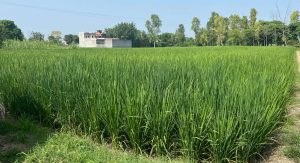 Farmers who adopt direct seeded rice (which improves water use efficiency) and no tillage practice (which conserves soil organic biomass) are eligible for getting carbon credit © Adeeth
Farmers who adopt direct seeded rice (which improves water use efficiency) and no tillage practice (which conserves soil organic biomass) are eligible for getting carbon credit © Adeeth
This approach provides farmers with a financial incentive to adopt sustainable practices, such as not burning residues. By participating in such initiatives, farmers contribute to climate change mitigation efforts while also potentially improving their own livelihoods. The involvement of a third-party verifier helps ensure the integrity and credibility of the process, providing assurance to all stakeholders involved.
Steps in Carbon Credit Generation and Sales
The process of generating and selling carbon credits involves several stakeholders (Figure 1). First, a project developer conceptualizes and designs a project, preparing a project document according to a specific carbon offset program’s[2] requirements. Organizations like Verra and Gold Standard serve as certifying bodies, establishing standards and methodologies for different sectors. There are basically two types of projects based on the partners – those developed and implemented by carbon companies themselves and those implemented with implementation agencies (NGOs). For example, some of the project proponents in India are startups such as Boomitra Inc., Grow Indigo Private Ltd., Nurture Agtech Private Limited, Varaha ClimateAg Private Limited, Value Network Ventures Advisory Services Pvt. Ltd., and companies such as Godrej Agrovet Limited and Landmark Agri Exports Private Limited.
Once the project design is complete, farmers implement sustainable agricultural practices with the assistance of the companies or implementation partners (NGOs/farmer collectives), and the resulting emissions reduction/ carbon removal is measured and reported by project developers. Third-party bodies validate and verify these reductions. Upon successful verification, carbon credits are issued, which can be sold in the marketplace or through over-the-counter deals with corporate buyers. A real example is provided in Box 2.
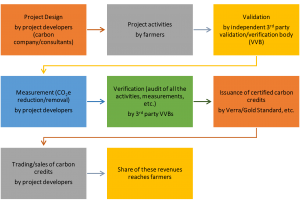 Figure 1. Carbon farming project: from project design to revenues from carbon credits.
Figure 1. Carbon farming project: from project design to revenues from carbon credits.
| Box 2: How a real carbon farming project works Project name and Verra ID: Sustainable Rice Cultivation for Marginal Farmers in Madhya Pradesh, India (3156) Project proponent: Value Network Ventures (VNV) Advisory Services Pvt. Ltd. Implementation partner: Shriram Education and Welfare Society (NGO) Target: 28,082 farmers covering around 31,848 hectares The project proponent (VNV) designs the whole project, selects the intervention, area of intervention, and the scale based on their and the implementation partner’s capacity. The project proponent trains the implementation partner (NGO) on the interventions (AWD here) and tasks them to onboard farmers to the project. The NGO also collects basic information on farmers, like the agricultural practices followed and GPS of plots to establish the baseline and monitor the plot using remote sensing. The NGO’s role is to enroll farmers, create awareness about AWD, supply AWD pipes, install AWD pipes in farmers’ field, ensure that the farmers continue using AWD, monitor and assist the third-party validation/verification bodies (VVBs) during the audit. VNV creates the baseline, measures emissions reductions, takes care of all the documentation with Verra, validation and verification processes, and reporting and sales of carbon credits. Generally, the project proponent takes care of all the costs (registration, validation, verification, and project costs) at the beginning of the project. Once the carbon credits are sold, they subtract this cost from the gross revenue from the sales of carbon credits and share a percentage of the net revenue with the NGO and farmers. Farmers usually get the higher share of the net revenue. Based on our discussions with various project proponents, around 55-70% of the net revenue reaches farmers. Note that the project is still under development and therefore, none of the farmers might have received income from carbon credits. Disclaimer: Please note that this description is a general overview and interpretation of a real carbon farming project. Actual project implementation may vary. This interpretation should not be considered an exhaustive representation of the project’s intricacies. Interested parties are encouraged to consult official sources and engage with project proponents and stakeholders directly for a more comprehensive understanding of individual carbon farming projects. |
POTENTIAL OF CARBON FARMING
As on 26 September 2023, a total of 41 agriculture land management projects are listed in the Verra registry[3] with an annual estimated emissions reduction of 27 million tons CO2e. This reduction is equivalent to getting 6 million gasoline-powered passenger vehicles off the road for a year[4]. This converts to 27 million carbon credits, the value of which might be around INR 2200 crores (@US$ 10 per carbon credit[5]). Assuming 60% of this reaches farmers, it amounts to around INR 1300 crores. This amount is equivalent to the combined budget allocated for Central Sector Schemes/Projects, like the formation and promotion of 10,000 Farmer Producer Organizations (FPOs) and Agriculture Infrastructure Fund (AIF)[6].
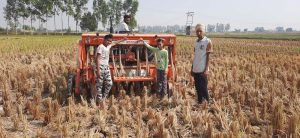 Happy seeder is an ideal solution to the problem of crop residue burning as it helps reduce GHG emissions (©CIMMYT)
Happy seeder is an ideal solution to the problem of crop residue burning as it helps reduce GHG emissions (©CIMMYT)
Sustainable agriculture practices for carbon credits
Carbon farming projects in India should aim at reducing the environmental impact of crop residue burning, groundwater extraction, overuse of chemical fertilizers, land degradation, paddy cultivation, milk production, and food loss and waste. Potential interventions might include zero/minimum tillage, direct seeded rice (DSR), alternate wetting and drying (AWD) of paddy fields, using an optimum combination of organic and chemical fertilizers, biochar, intercrops, cover crops, balanced diet for livestock, biogas plants, etc. A few carbon farming projects listed in the Verra registry are given in Table 1.
Table 1. Indian carbon farming projects at various stages of registration listed in Verra registry.
| Project name | Project proponent (s) | Location | Interventions | Registration status | Annual estimated emissions reduction (tCO2e) | Duration of the project |
| Improved agricultural practices for rice cultivation in India | Kosher Climate India Pvt. Ltd. | Assam and West Bengal | Alternate Wetting and Drying (AWD) | Registration requested | 217,728 | 2023-2043 |
| Sustainable agricultural practices for carbon sequestration by organic and natural farming groups | Vedic Green Solutions
and Kanaka Management Services Private Limited |
Karnataka | Organic manure, cover crops, crop rotation, residue retention, agroforestry | Registration and verification approval requested | 556,903 | 2017-2057 |
| GHG emission reduction through intermittent flooding in rice fields | Landmark Agri Exports Private Limited | Madhya Pradesh | AWD | Under validation | 58,722 | 2020-2027 |
| Maharashtra and Gujarat initiative for regenerative agriculture and income creation | Grow Indigo Private Ltd | Maharashtra and Gujarat | Fertilizer and water management, cover crops, zero- or reduced-tillage, crop rotation, agroforestry | Under development | 4,861,245 | 2020-2040 |
| Sustainable agriculture land management project | Suminter India Organics and EKI Energy Services Limited | Madhya Pradesh | Reduce tillage/improve residue management, reduce fertilizer application, soil probiotics or other amendments, improved water management/irrigation, cover crops, crop rotation and intercrops | On hold | 275,748 | 2017-2047 |
Note: These are the largest projects in terms of annual estimated emission reductions in various stages of registration.
PROBLEMS FACED BY FARMERS AND THE ROLE OF AGRICULTURAL EXTENSION
Preliminary findings from the survey of carbon farmers[7] conducted by CIMMYT in 2 states of India covering 7 carbon credit projects revealed that a major share of farmers enrolled in carbon farming projects did not receive any kind of training on the interventions. Also, farmers had little knowledge about the written/digital contract with the company, ownership of carbon credits generated and the whole process of carbon crediting. Furthermore, most of the farmers highlighted that the company did not contact them or share any information after they had enrolled in the project. These observations underline the need for training and farmer engagement for the success of individual carbon farming projects and the larger goal of climate change mitigation. Thus, proven models of agricultural extension should be used by the companies who could hire qualified extension professionals or devise context-specific strategies for better engagement, information sharing and training of farmers.
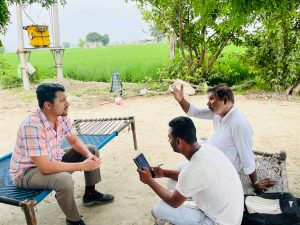 Interviewing a carbon farmer in Haryana ©Pravakar Behera
Interviewing a carbon farmer in Haryana ©Pravakar Behera
CONCLUSION AND RESEARCH QUESTIONS
When properly planned and implemented, carbon farming projects offer promising avenues for both climate change mitigation and farmer prosperity. By reducing GHG emissions and generating carbon credits, agriculture can play an important role in addressing the global climate crisis. As policymakers, organizations, and individuals embrace carbon markets and incentivize sustainable practices, we can move closer to a sustainable and resilient future for the planet. The time to act is now, and the potential rewards are immense.
CIMMYT is working on various aspects of carbon farming through quantitative surveys, case studies and stakeholder interviews across India and Africa. Following are some research questions to explore for interested researchers:
- Have carbon farming projects effectively reduced GHG emissions? What are the quantifiable impacts on emissions reduction?
- To what extent have smallholder farmers participated in carbon farming projects, and what factors influence their participation?
- What innovative technologies and methods can enhance the accuracy and cost-effectiveness of GHG emission measurement and verification in carbon farming projects?
- To what extent are consumers aware of and willing to support products associated with carbon farming projects, and what factors influence their choices?
- What are the gender and equity implications of carbon farming projects, and how can these projects be designed to ensure social inclusion and gender equity?
- Is there information asymmetry among the stakeholders of carbon farming projects? How can their effects be reduced?
REFERENCES
Crippa, M., Solazzo, E., Guizzardi, D., Monforti-Ferrario, F., Tubiello, F. N., & Leip, A. (2021). Food systems are responsible for a third of global anthropogenic GHG emissions. Nature Food, 2(3), 198–209. https://doi.org/10.1038/s43016-021-00225-9
Glennerster, R., & Jayachandran, S. (2023). Think globally, act globally: Opportunities to mitigate Greenhouse Gas Emissions in low- and middle-income countries. Journal of Economic Perspectives, 37(3), 111–135. https://doi.org/10.1257/jep.37.3.111
Ritchie, H., Roser, M., & Rosado, P. (2020). CO₂ and Greenhouse Gas Emissions. Our World in Data. https://ourworldindata.org/co2-and-greenhouse-gas-emissions
Foot Notes:
[1] This is a hypothetical example. The GHG emissions reduction, carbon prices and the revenue received by the farmer might all vary.
[2] The major carbon offset programs/crediting mechanisms/certifying agencies are Verra, Gold Standard, Climate Action Reserve (CAR) and American Carbon Registry (ACR).
[3] https://registry.verra.org/app/search/VCS/All%20Projects
[4] https://www.epa.gov/energy/greenhouse-gas-equivalencies-calculator
[5] Prices can vary between $1-6 in marketplaces and between $10-25 in over-the-counter deals. For example, climes.io sells carbon credits to consumers at around $24.
[6] https://www.indiabudget.gov.in/doc/eb/allsbe.pdf
[7] More details and specific findings of the survey cannot be divulged currently as it is an ongoing investigation.
 A.G. Adeeth Cariappa is a Post-Doctoral Fellow- Environmental and Resource Economist at CIMMYT working on carbon credits in agriculture under One CGIAR Regional Integrated initiative Transforming Agrifood Systems in South Asia (TAFSSA). He can be reached at Email: a.adeeth@cgiar.org
A.G. Adeeth Cariappa is a Post-Doctoral Fellow- Environmental and Resource Economist at CIMMYT working on carbon credits in agriculture under One CGIAR Regional Integrated initiative Transforming Agrifood Systems in South Asia (TAFSSA). He can be reached at Email: a.adeeth@cgiar.org

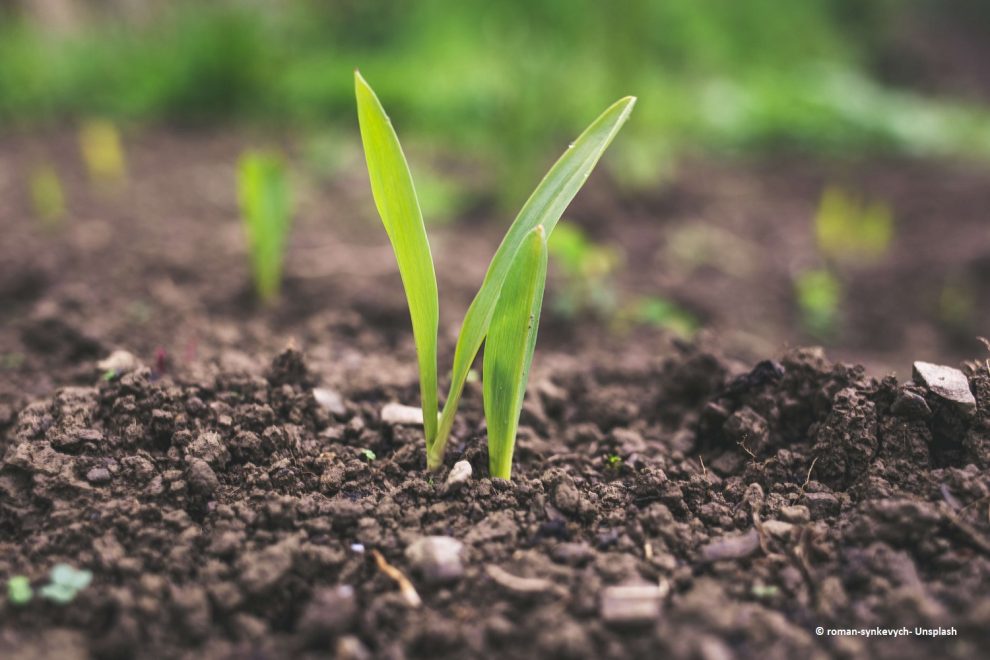

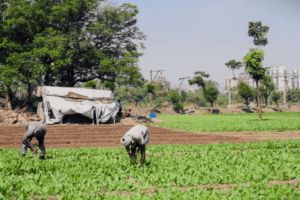

Very important and interesting blog on carbon credit with huge ecological and economic benefits to farmers and society. The concept, context, problems and prospects, efforts made, people and agencies involved , research, extension and training gaps in the area are well discussed. I strongly feel that even policy support and implementation efforts are not adequate. Congrats to the author and AESA for sharing the blog.